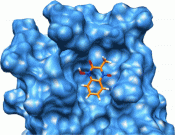Gallic acid-based small-molecule inhibitors of JC and BK polyomaviral infection.
Abstract
JCPyV and BKPyV are common human polyomaviruses that cause lifelong asymptomatic persistent infections in their hosts. In immunosuppressed individuals, increased replication of JCPyV and BKPyV cause significant disease. JCPyV causes a fatal and rapidly progressing demyelinating disease known as progressive multifocal leukoencephalopathy. BKPyV causes hemorrhagic cystitis and polyomavirus associated nephropathy in bone marrow transplant recipients and in renal transplant recipients respectively. There are no specific anti-viral therapies to treat polyomavirus induced diseases. Based on detailed studies of the structures of these viruses bound to their receptors we screened several compounds that possessed similar chemical space as sialic acid for their ability to bind the virus. Positive hits in the assay were restricted to gallic acid based compounds that mimic the viruses known cellular glycan receptors. Pre-treatment of virions with these inhibitors reduced virus infection in cell culture and as such may form the basis for the development of virion specific antagonists to treat these infections.
http://www.ncbi.nlm.nih.gov/pubmed/24960120


